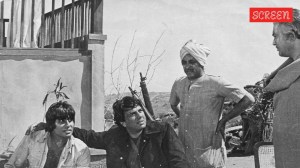Military Digest | Remembering Air Marshal A D Joshi and his pioneering MiG-23 landing at Leh
A former commander-in-chief of the IAF’s Strategic Forces Command, Air Marshal A D Joshi pioneered many firsts that put India in a commanding position vis-à-vis China and Pakistan in the 1980s and 1990s.
 Air Marshal (then Wing Commander) A D Joshi with a MiG-23 aircraft in Leh.
Air Marshal (then Wing Commander) A D Joshi with a MiG-23 aircraft in Leh.Air Marshal A D Joshi (retd), who passed away on February 23 following an illness, was a former commander-in-chief of the Strategic Forces Command and a fighter pilot who had seen operational flying over a career of four decades. His first landing of a MiG-23 BN fighter bomber at Leh is worth recounting in his memory.
The employment of a variety of fighter aircraft at Leh and Thoise over the previous decades has culminated in the operational sorties now flown by Rafale—the latest aircraft in the inventory of the Indian Air Force. However, much credit goes to intrepid flyers like Air Marshal Joshi, who pioneered many firsts that put India in a commanding position vis-à-vis China and Pakistan in the 1980s and 1990s.
A detailed account of the maiden MiG-23 landing at Leh was written many years ago by Air Marshal Joshi for the military affairs portal Bharat-Rakshak.com. The article provides a firsthand account of the difficulties associated with the effort and how these were surmounted.
The MiG-23’s induction in Ladakh took place against the backdrop of Operation Meghdoot, the Army’s occupation of the Siachen Glacier, which began on Baisakhi Day in April 1984. The IAF also had an important role to play in the operation, not solely on account of the extensive involvement of fixed-wing transport and helicopters but also because of fighter bombers that could dominate the battlefield and keep the enemy at bay.
Initially, Hunter aircraft were proposed for this purpose, but given the limitations of the weapons capabilities of that aircraft, the IAF headquarters decided that the MiG-23 BN would be the optimum choice.
Air Marshal Joshi was the officiating commanding officer of No. 221 Squadron, equipped with this aircraft and based out of Pathankot for carrying out operational sorties in support of Operation Meghdoot. However, while the squadron could reach the operational areas from Pathankot, the reaction time would have been far less had there been a detachment available to be deployed from Leh itself. For that, the aircraft would have to be made operational by landing at Leh, something that had not happened until then.
Air Marshal Joshi wrote in his article that the squadron had prepared for the Operation Meghdoot role even while based at Pathankot, with plenty of valley flying done under his command and simulated attacks practised on mountain tops. Diversionary landings at Leh were also practised.
Joshi mentioned that the landing approach to Leh was only for Runway 07. One was a direct approach from Khalsi, and the other was a standard circuit descending on downwind and base leg like the transport aircraft. The circuit for Runway 07 was behind the mountain range, and the approach was along the slope of the mountain.
The challenge for a fast-moving, supersonic-capable, sweep-wing aircraft like the MiG-23 was that the airfield could not be seen on downwind and base leg and became visible just prior to rolling out on finals. “The approach all along was just 50 meters above the slope and there was a big hump just after the Indus River and short of the 07 dumbbell, and a lot of care had to be taken when doing an overshoot after round off, as the engine response and speed build up was slow,” wrote Air Marshal Joshi.
Arjun Prakash Iyer and Shwetabh Singh have also described the operation in detail in their research paper, ‘Swing Wing Heroes of the Himalayas: Story of the MiG-23s and MiG-27s Defending the Northern Borders of India,’ for Centre for Air Power Studies (CAPS).
They recounted how the D-Day dawned on May 23, 1984, and at 10 am, a four-aircraft formation took off from Awantipora and headed towards Leh. The formation consisted of Squadron Leader Joshi in one MiG-23 BN and two other MiG-23 MF as escorts. As they approached Leh, the escorts and the second MiG-23 BN peeled off, leaving Squadron Leader Joshi to perform the landing.
Writing about the challenges of conducting the landing, Joshi noted that the permissible hub speed for the undercarriage of the aircraft was 320 km/h for the main wheels and 280 km/h for the nose wheel. The altitude of Leh being 3,256 m, the true airspeed at touchdown was approximately 60 km/h more than the indicated air speed (IAS). He added that the tail chute limitations of less than 280 km/h were another factor to consider.
“Therefore, it was necessary to keep the aircraft floating for as long as possible, so as to ensure that the touchdown True Air Speed (TAS) would be less than 320 km/h and the nose wheel lowering as well as the tail chute deployment would be less than 280 km/h,” Joshi wrote.
Joshi carried out practice circuits overhead Leh and overshoots to bring the fuel to as low as possible. When the fuel state reached 550 litres, he decided to land the aircraft, as the available fuel did not permit another circuit. If he had failed to land, it would have resulted in an ejection due to lack of fuel.
“I reduced the throttle gently, allowed the aircraft to float and touched down at a speed of 240 km IAS. Things moved in a flash and at a speed of 220 km IAS, I lowered the nose wheel and deployed the chute. The aircraft rolled till the end of the runway under control,” Joshi wrote. History had been made.
Writing for CAPF, Arjun Prakash Iyer and Shwetabh Singh recounted how the very next day, on May 24, two MiG-23 MF from No. 223 Squadron—flown by its commanding officer, Wing Commander I J S Boparai, and flight commander, Squadron Leader P S Guram—also landed at Leh.
More than 10 years later, on October 28, 1995, Wing Commander Pradeep Kinra, Commanding Officer of No. 224 Squadron flying MiG-23 MF, and the squadron’s Senior Flight Commander, Squadron Leader Ganesh Chand, took off from Adampur and successfully landed at Thoise.
These feats must not be forgotten, nor should the men who achieved them.
Air Marshal A D Joshi is survived by his wife and three daughters.







